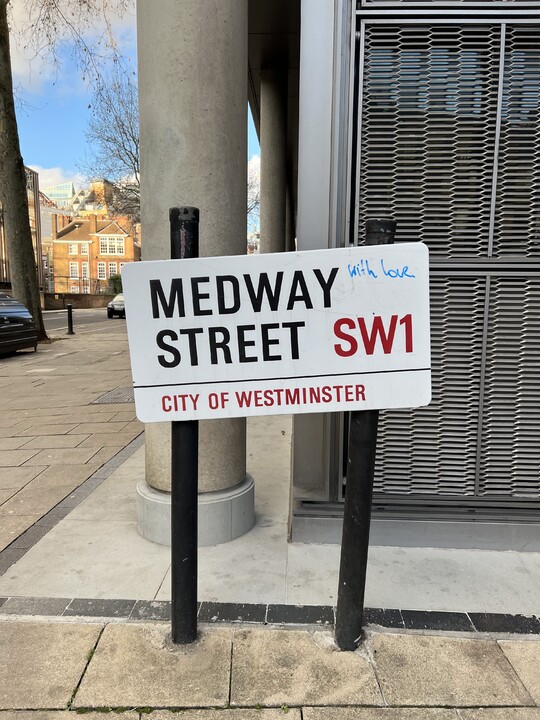
What's in a name? Street Signs and Navigation in a City
I still remember the first time I went to my neighbourhood grocery store, as a child, all by myself. Familiar street, and a stone's throw away from home, the feeling of independently going to shop is still fresh in memory. I felt confident and trusting, and I had a strong desire to explore more. Pedestrian navigation involves fundamental spatial behaviours, skills and services of people helpful in unfamiliar environments.

Unlike cargo, humans engage in wayfinding and navigation, two distinct processes to get from point A to B, usually with a goal in mind or as a part of a process. Lynch (1960) defines wayfinding as "the process of finding way to a destination in a familiar or unfamiliar setting using any cues given by the environment." A complex psychological and physiological process, wayfinding includes human and environmental factors that could affect how humans feel and use available cues to find way. For example, human factors are "spatial orientation, cognitive mapping abilities, route strategies, language, culture, gender and biological factors". Environmental factors include the nodes, edges, paths, districts, landmarks, and signs. Pedestrian navigation focuses on the guidance process of pedestrian travel behaviour between identifiable origins and destinations. (Fang, Li and Shaw, 2016).
Adapting Maslow's theory, Fang, Li and Shaw (2016) identified three layers of pedestrians' needs- Physical senses, physiological safety and mental satisfaction. Pedestrians have visual, auditory, tactile, and olfactory senses, which perceive navigation instruction information from pedestrian navigation systems or services. These senses supply navigation instructions to the pedestrian's brain, and this sensed information can influence decisions of spatial behaviours in surrounding environments. Pedestrians are usually concerned for their safety in many situations during navigation. For example, pedestrians could fall or cause accidents when they pay too much attention to navigation systems or services and could be misled by a navigation device. The paper states that the satisfaction of pedestrians in the navigation process requires comfort, confidence, and respect. In the aspect of comfort, visual saliency has attracted much attention to assess comfort from the perspective of cognition. Many factors influence pedestrian comfort, such as "weather, security, appeal, traffic, pavement conditions, noise, air pollution, and layout of the walkway" (Dang, Iwai, Tobe, et al., 2013).
What may seem like a simplistic name tag, so abundantly present, often going unnoticed, street nameplates serve an essential purpose, assisting the public in navigating through a city's road network. Street name signs are essential identifiers. Pedestrian navigation is one of the most fundamental spatial behaviours, and skills, helping users make sense of new environments. 'Public ' is quite a generalising term to explain the diversity and varying needs of road users. Some of the many users could be emergency services operators, young students walking to school, delivery partners navigating through lanes and by-lanes, general pedestrians walking, tourists, physically abled, senior citizens, and so on. People use streets differently and for diverse activities.

During my daily walks in London, I come across nameplates on every street corner, either mounted on walls, buildings or at the back edge of the footway. London's Streetscape Guide states: "Design teams should aspire to implement a traffic sign system that embraces the significant innovations in traffic engineering and policy. Therefore all unnecessary signage should be removed from the network, especially where identified as a roadside distraction or visibility hazard. This will ensure that the road network is better managed and will enhance the quality of the streetscape. The purpose of signage is to provide clarity for the user, it should have a clear purpose and convey necessary information. In addition, signs can be combined with other street furniture, signals or mounted on buildings which can reduce clutter on the footway."

Removing or reducing clutter from the line of sight of drivers and pedestrians is crucial to road safety behaviour and navigation, aiding in seamless wayfinding. In crowded streets, however, it is common for road signages to be hidden between several competing stimuli like flashy posters, wires, pedestrian and traffic volumes, and other obstructing street furniture, leaving road users heavily dependent on app-based geographic information systems (GIS) tools. Street nameplates, as such, take modest physical space and provide important information like postcodes, borough/ward details and the street's name, unfettered by rain, wind, or snow!
The abundance and salience of street nameplates across London instil confidence, allowing me, as a pedestrian, to independently explore the streets and remember them for longer. In unfamiliar streets, visible from a distance, the strong contrasting black and red text on white saliently reassures (The use of red varies across boroughs), significantly making wayfinding less stressful. In addition, several small, perceivably insignificant tools on our roads aids users greatly. I have wondered so many times about what I would do without Maps on my phone. I can answer with confidence now- I'd look for signages and recommend the same to you.
Are such road signs helpful? Have you come across them in your city? I'd love to know your thoughts on these bilingual road signs for Kolkata. Forgive me for any spelling errors - I have to brush up on my Bengali writing skills!

